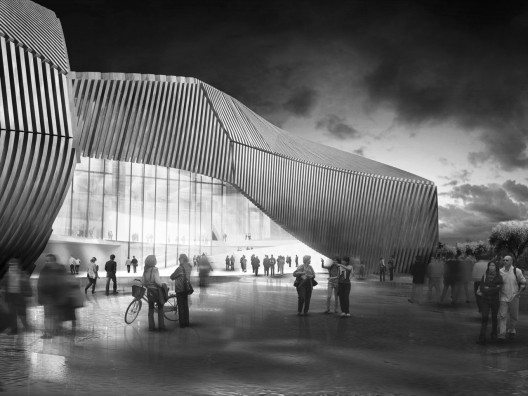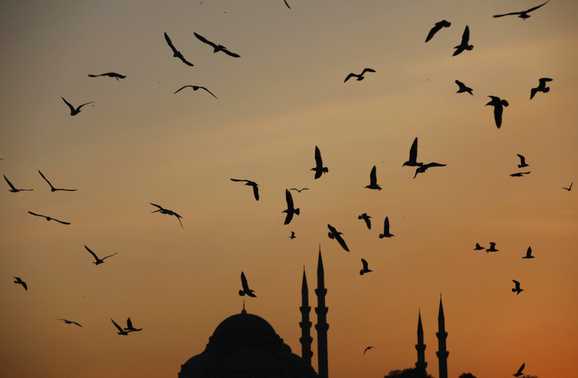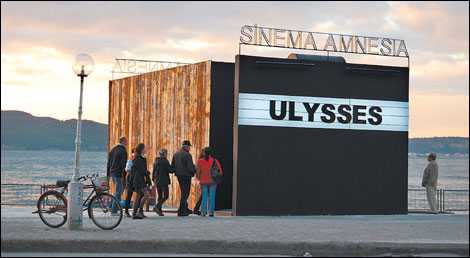By Christopher Henry
The design of the Museum of Troy at Çanakkale has been carried out by the atelier RTA-Office, led by Santiago Parramón with offices in Barcelona and Shanghai, in collaboration with the Turkish atelier DOME Partners (Istanbul). The aim is that the building rises in the Turkish area of Çanakkale but aspires to be a global focus through its expression and display of the culture of a civilization. A project that will act as a generator for social activity, research and culture.
rendering
Both RTA-Office and Dome Partners agreed to design the building in such a way that it would become an event generator, that a centre for cultural expression would become an international lure. A work that would launch an area with the objective of re-evaluating and re-establishing the immense worth that this civilization had at a global level.
The strategy consists in the design of a unique piece, a jewel, that on the one hand will complement the ruins of Troy, and on the other be valued in its own right. The starting point is to recapture with the utmost sensitivity the magnificence of this civilization that in its golden era created the most beautiful objects, full of splendor and creativity.
The Museum stands in nature as a work delicately crafted by the hands of artisans. A piece that stands out from the land but at the same time respects the dignity of the natural environment. Its lines are reminiscent of the geometry of Troy; its strained curves, planes and intersections that cut suddenly, the meetings between concave and convex. Movement is captured in the building’s surfaces, where one detects the influence of the artist Boccioni in the interaction of an object in movement with the space around it, through the intuitive search for a single form that creates a continuous space.
rendering
A venue of experience
A space that enables everything from a contemplative walk to group activity. A well organized ensemble that advances a system and multiplicity in its possibilities and activities. A place that proposes we “live Troy” as an experience, not somewhere merely informative This experience begins on arrival when, after parking in the car park, well away from the main road, the visitor is directed to the building via a deliberate trip through olive groves that provide shade, cool and texture, and through which one discovers the building.
Beneath an imposing wooden “umbrella” one finds the building events program. In the interior is a space of dynamic and changing perceptions, an open, obstacle-free area, a continuation of nature. A great square, open to the exterior like a receiver and distributor of activity from which one accesses the bar-buffet and children’s play area. In front of this one finds the commercial zone and the amenities, and to the west the ticket sales.
Through this low area, appearing to have been excavated, giving the feeling of entering an archaeological site, is the control area and the main entrance to the Museum. This is where the perception of space changes radically; one is once again under the truly massive structural cover of the building and, in front, there is a ramp, following the original topography of the land, which leads to the exhibition areas. At the end is the archaeological research zone in an area excavated from the ground, three metres below the access level to the permanent exhibition space. Thus visitors can see the pieces that are being worked on and researched in the field.
The restaurant has a great exterior terrace over a large platform of water in which the adjacent olive groves and recreation areas are reflected. At the end of the permanent and temporary exhibition spaces, as an end to the journey, are the auditorium and a bar. It is the foyer that creates the connection between these two purposes and facilitates the use of the bar and foyer for events, conferences and congresses. Following the visit to the museum space one descends towards the great hall down some splendid ramps.
The building also is also full of daily activity with the management offices, the commissary and the researchers situated in the west wing where the topography rises some four metres over the access zone to the main hall. Continuous interior and exterior spaces inter-communicate and transport the natural light that penetrates the skin of the building with the aim of producing an agreeable and comfortable atmosphere.
model
Creation of space
The principal characteristic of the Museum of Troy is the creation of space versus the creation of form. The result is a single volume configured as a unitary whole. An elegant body of refined and sinuous, interlocking lines that surround and allow one to traverse. A unique building, a “Great Museum”, an expression of an era and a great vision of the future. Poetry and technology for the human condition.
The strong material expression is achieved by using a single material, wood, which has been specially chosen, both for the structure and the skin of this building, for its elegant and evocative texture, its comfort and because it pertains to nature and to the location. It is also the only material that could provide the building with zero CO2 emissions.
Sustainability and energy efficiency
A fusion between the latest modeling technology and the construction of space in three dimensions, a highly refined exercise in the harmonious integration of the countryside and a strong commitment to sustainability in energy efficiency and the fitting out of the building.
The aim is that the building is environmentally responsible, profitable and healthy, so as to be able to live and work in it with a good quality of life. To this end synergies between disciplines and technologies have been established. The RTA-Office and Dome Partners proposal seeks to make use of the best practices in the design and construction phase to reduce significantly or eliminate any negative impact of the building on the environment and thus achieve Leadership in Energy & Environmental Design (LEED™) so that the building be certified “green” by the Green Building Council (WorldGBC), New York. A new global benchmark in this field. The aim of the energy efficiency in the new building is an energy saving of about 70% and the maximum energy efficiency rating “A”. This is based on three fundamental pillars: economy, sustainability and quality of life.
Architect: RTA-Office, DOME Partners
Location: Çanakkale, Turkey




